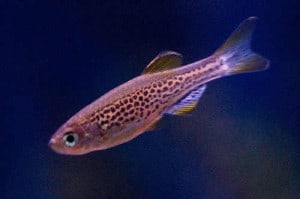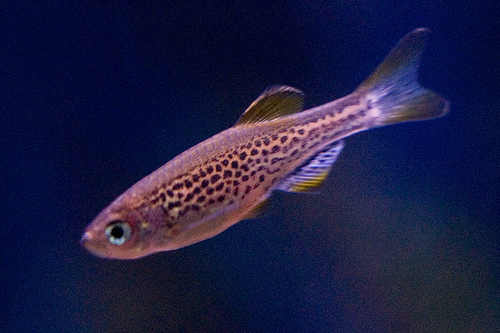
Common name: Leopard Danio
Scientific name: Danio Rario Variety Frankei, Cyprinus Chapalio, Brachydanio Rerio, Perilampus Striatus, Brachydanio Frankei
Average Adult Fish Size: 2 inches / 6 cm
Place of Origin: India
Typical Tank setup: Well planted with rocks and driftwood/bogwood. They love playing in a moderate to strong current.
Recommended Minimum Aquarium Capacity: 10 gallon / 40 litre
Compatibility: All Danio species are very peaceful and very active. The Leopard Danio is no exception. They do very well in a community aquarium made up of other peaceful fish of similar size.
Temperature: 65 – 80 Deg F / 18 – 27 Deg C This hardy species is well suited for unheated aquariums.
Water chemistry: pH 6.0 – 8.0
Feeding: They are omnivorous and do very well on a varied diet of quality flake foods, micro pellets, daphnia, microworms, and brine shrimp.
Sexing: Males are slimmer and more intense in their coloration than females.
Breeding: Well conditioned Leopard Danios are very easy to breed. They can be breed both in pairs and in schools. Both methods have advantages and disadvantages.
A unique quality of the Leopard Danio is that as they are quite loyal to their chosen mate. Mated pairs remain together for life, and rarely spawn with others, even if one mate dies. The best way to obtain a mating pair is to start with a school of a half dozen or more young Leopards, and allow them to choose mates.
The breeding tank should be set up with shallow water, approximately six inches deep. Furnish the tank with java moss, fine-leafed plants, or a spawning grid on the bottom. Coarse gravel works well, as the eggs will fall between the gravel pieces and will be protected from the adult fish, which will readily eat their own eggs.
Spawning requires temperatures of up to 78 degrees, and can be triggered by raising the water a couple of degrees near dawn, when spawning normally occurs. 300 to 500 eggs will be scattered across the bottom and on the plants. Remove breeders after spawning, as they will consume the young.
The fry will hatch in two days. Fry are very tiny, and can easily be lost when changing water, so take care when maintaining the grow-out tank. Feed the young commercially prepared fry food, or finely crushed dry foods. Powdered egg may also be added to the fry food to promote growth.
Additional Information: All Danios are very active and prone to jumping out of even the smallest gap in an aquarium cover. A tight fitting lid is a must. Leopard Danios normally stay at the top-most levels of the aquarium and do better in schools of 6 or more. There are many varieties of the species Danio Rario consisting of Zebra Danios, Leopard Danios, and more. All are available in regular, long-finned, and albino varieties.


Related Posts
Croaking Gourami – Trichopsis vittatus
Benthochromis Tricoti
Large-eyed Mouthbrooder – Callochromis Macrops